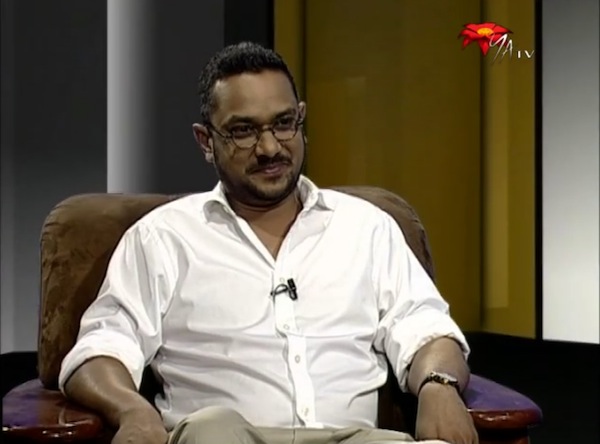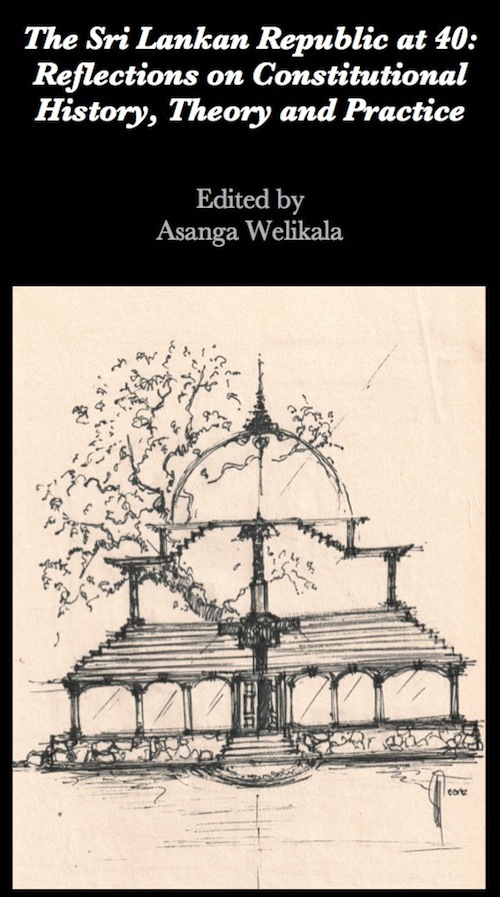The Sri Lankan Republic at 40: Reflections on Constitutional History, Theory and Practice is a collection of scholarly essays marking the 40th anniversary of the establishment of the Sri Lankan Republic in 1972, edited by Asanga Welikala. Spanning two volumes and at over 1,100 pages, this is not a tome that can be compressed into 24 minutes of an interview for public television. What Asanga does do is to look at key leitmotifs in the book and look at how the process leading to and the substance of the 1972 constitution continues to influence present day constitutional challenges and the timbre of governance.
We begin our discussion by flagging the sketch featured on the cover of the book as well as on a separate page within it, by well-known architect Sunela Jayewardene. Flagging his collaboration with Sunela in Mediated, Asanga notes that the sketch is a visual representation of several of the key aspects of the first republican constitution, including its unitary nature, and the foremost place given to Buddhism.
We then look at the three quotes Asanga had chosen for the frontispiece of the tome,
“The people cannot decide until someone decides who are the people.” – Sir Ivor Jennings[1]
“The Constitution was ceremoniously adopted…to the beating of drums and the sounding of conch shells…It was a great occasion for the people of Sri Lanka as it was able to remove the last vestiges of colonialism…” – Sirimavo Bandaranaike[2]
“The Constitution has given everything to the Sinhalese and has given nothing to the Tamils.” – S.J.V. Chelvanayakam[3]
Asanga responds to whether these three remarkably divergent viewpoints remain useful frames to critique the crises of constitutionalism 40 years after the first republic constitution. We then look at why the 1972 constitution repudiated what Dr. Paikiasothy Saravanamuttu in the introduction to the book calls a “liberal democratic post-colonial constitutional inheritance”. Asanga’s answer on this score flows naturally to the next point in our discussion, wherein he addresses whether the perception of elitism with regard to liberal democratic values bedevils their traction and acceptance amongst a broader polity and society.
The next segment was pegged to two quotes – one by R. Sampanthan MP, Leader of the Tamil National Alliance (TNA), who ends an interview in the book by saying, “we would all be looking towards a Sri Lankan nationalism and a Sri Lankan nation, where you can be a Tamil but nevertheless a true, proud Sri Lankan” and the other by Prof. Ratnajeevan Hoole, who notes, after expressing second thoughts about returning to Sri Lanka, that “Our talents and culture, so rudely rejected in Sri Lanka, are welcomed and used [in Canada] with appreciation, making me ask ‘Where is home?'”
Asanga looks at how the question of identity, and identity politics in Sri Lanka, mirrored in and often exacerbated by constitution making and governance, continues to stunt Sri Lanka’s democratic potential. Asanga’s response also compares and contrasts India’s post-colonial identity politics and constitution making with Sri Lanka’s own trysts with destiny, and the markedly different trajectories of both countries in this regard.
Asanga is then to look at the four decades since 1972 and extrapolate the key lessons that are vital to any process of constitution making in the future, moving beyond what Dr. Paikiasothy Saravanamuttu in the book frames as the politics of hate, hurt and harm. He also goes into why this book is necessary, even though it is firmly anchored in the domain of academia and isn’t aimed at the general public or casual reader.
The next point in the discussion address a point made by Udaya Gammanpilla, the Legal Advisor to the Jathika Hela Urumaya (JHU), who explicitly notes in an interview featured in the book that “after 1983, Sinhalese have never attacked Tamils”. Asanga looks at how this Sinhala-Buddhist majoritarian mindset (especially since 1972), and the real violence it hides, feeds into constitution making and governance.
The interview ends by flagging an excerpt from the contribution of Ambika Satkunanathan, which notes that,
“The silence of women in the dominant narrative of conflict and displacement has to be acknowledged and challenged, since “The ‘not telling’ of the story serves as a perpetuation of its tyranny,” which has the potential to provoke deep distortions in memory and the organisation of everyday life later on.” (from N. de Mel (Ed.) (2007) Militarizing Sri Lanka: Popular Culture, Memory and Narrative in the Armed Conflict)
Applying this more broadly to the process of constitution making and the need of those who ideate and draft constitutions to be more sensitive to the aspirations of all peoples, Asanga’s asked how in the future constitutions can be more sensitive to those who are marginalised and silenced.
[1] (1956) The Approach to Self-Government (Cambridge: CUP): p.56.
[2] (2005) Memoirs of Sirima R.D. Bandaranaike: Ceylon becomes Sri Lanka, The Sunday Observer, 24th April 2005.
[3] (1972) Debates of the National State Assembly, 3rd October 1972: Cols.883-884.



